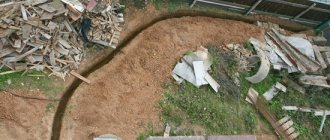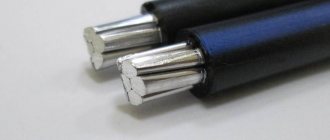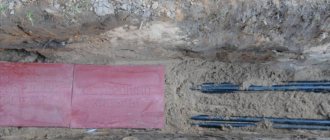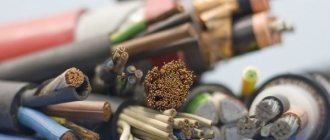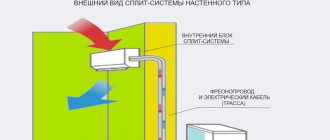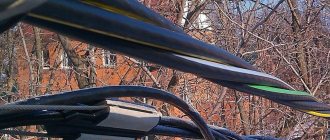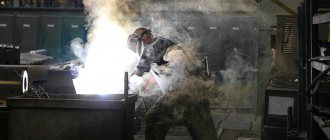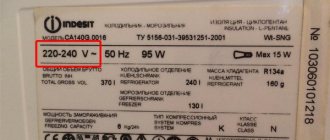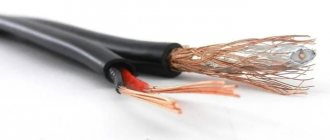Without power supply, the bathhouse building will not be able to function normally. Switches, lamps, sockets, heat-resistant cable for the bath are integral parts of the system. Wires for the sauna in each room are selected based on its purpose, different temperature conditions and the presence of moisture.
A network is laid in the steam room to create artificial lighting and connect an electric furnace. In the washroom - for light and a water heater, and in the dressing room - for appliances, for example, a hairdryer, TV or kettle. Let us consider in detail which wire to use for wiring in the bathhouse.
Electrical wiring installation
In a steam room, the wire insulation must withstand up to +170°C
. Before you make a steam room with your own hands, you need to remember that due to humidity and high air heating, certain fire safety requirements are imposed on the wiring. In the steam room, the wire insulation must withstand up to +170°C.
Cable brands used:
- flexible stranded copper wire of the PRKA, PVKV, RKGM, PRKS categories;
- multi-wire and single flexible wire PMTC (works up to +200°C);
- imported wire OLFLEX HEAT 205 (can withstand up to +200°C).
In steam rooms and saunas, wiring cables in iron pipes and shells is not allowed; hidden wiring in safety hoses and ducts is recommended. When the wiring is open, asbestos is placed under the cable so that 10 cm of lining material peeks out on both sides.
Plug-type sockets, switches, and distribution boxes should not be installed in wet steam rooms. The lamps are mounted in protective housings from moisture, protection class IP24, they cannot be placed on the ceiling, but only on the wall.
Preparatory work
In order to begin installation work, you need to prepare all the necessary materials and tools. These are cables of a certain cross-section, metal hose, sockets, switches, electrical tape. You should also prepare tools for electrical work. If the bathhouse was built on a stone or concrete foundation, then putty should also be prepared.
It is very important to choose the right cable. To determine the correct cross-section, determine the load for which the electrical wiring in the bathhouse will be designed
The rules recommend using a cable with a cross-section of 1.5 mm2 for a current of 19 Amps; for a current of 70 A, a cross-section of 10 mm2 is suitable.
You can also use the following formula: maximum possible load kW / voltage V
When making calculations, it is important to take into account all devices. As for the choice of metal hose, preference should be given to a more flexible option
The wall thickness must be at least 2 mm.
Cable selection
The requirement for temperature resistance of cable insulation was indicated above. But this is only for products laid around the steam room. All other cables or wires passing through the dressing room may not have such qualities.
The permissible core material for cables is copper. The use of aluminum in domestic buildings is allowed only if its cross-section is equal to or greater than 16 mm2. An exception is possible only for engineering equipment, which includes:
- air heaters;
- fans;
- air conditioners;
- pumps.
But even in this case, the cross-section of the aluminum core should not be less than 2.5 mm2.
But the minimum cross-section for copper cables used in domestic premises should not be less than 1.5 mm2 for lighting networks, and 2.5 mm2 for socket groups. What it should actually be is calculated based on the load current. Change is only possible for the better.
For single-phase consumers (lamps, sockets, exhaust fans, etc.), the number of cores in the cable should be three. If the lamp is controlled by a two-key switch, 4 wires are used.
The purpose of the cores in a three-core cable: phase, neutral and protective conductor. A blue core is always used as a neutral wire, and a yellow-green wire is used as a protective wire. For phase, what is left is usually white or brown. It is prohibited to use the blue or yellow-green conductors for any other purpose.
Three-core cable core colors
The same applies to five-core cables used to connect three-phase loads.
Purpose of cores in a five-core cable
Even if the socket does not have a grounding contact, and the lamp is enclosed in a plastic case that does not have a terminal for connecting grounding, a three-wire cable must still be laid to them.
How to hang a lampshade
Fixed installation lamp
Bath lamp with wooden shade
Classic bath lamp
There are so many lighting lamps that it is unrealistic to consider the connection of each of them. We will only talk about general universal rules.
Step 1: Turn off the network power. If the shield is located far away, be sure to hang a warning sign on it
This is very important, power supply switching on by mistake by third parties has happened more than once
Turn off the power to the sauna
Step 2. Study the lamp's instructions. If it is not there, disassemble the lampshade, find on the body the place where the power cables enter and where the body is fixed. We hope that the switch is connected correctly and the phase is connected through it.
Fastening and cable entry point
Mounting the lamp
Step 3. Attach the lamp to the wall or ceiling, before inserting the wires into the mounting holes on the body. Check the serviceability of the cartridge with a tester. Sometimes the pins are not attached in good faith; the contacts will overheat and burn out over time. Tighten all the clamps; if the terminals are riveted, touch them, they should not wobble.
Step 4. Strip the ends of the wires to a length of approximately 5 mm; if the cable is multi-core, tin the ends or at least twist them tightly. Insert into terminal blocks and tighten.
Step 5. Screw in the light bulb, check the wiring for a short circuit. Everything is normal - put the decorative lamp in place and turn on the power.
Fixed luminaires
Pay attention to the strength of the attachment of the lampshade to the supporting surface. If the lampshade is plastic, be sure to follow the recommended maximum wattage of the incandescent light bulb
For energy-saving lamps, completely closed shades cannot be used - they must be constantly cooled with fresh air.
Ventilated lampshade for a bath - diagram
Wooden grille for lamp
For thermal insulation of walls, floors and ceilings
To ensure that the steam room gains temperature faster and lasts longer, it is often insulated. Moreover, both the walls and the ceiling. As we said, the temperatures are serious, so not all materials can be used. Mineral wool is most often used. It meets fire requirements, however, there are difficulties with humidity: it does not tolerate getting wet. To solve this problem, a layer of vapor barrier is attached on top, which prevents moisture from penetrating inside.
Mineral wool
But the materials for mineral wool can be glass, slag and rocks. In addition, stone wools (from rocks) are also thin and ultra-thin. They all have different characteristics. What interests us most is that they can withstand different thermal loads. Technical characteristics of mineral wool of different origins are given in the table (BTV - thin basalt fiber, BSTV - basalt ultra-fine fiber).
Technical characteristics of mineral wool, temperature conditions of use
If you look only at temperature conditions, then any of the materials is suitable for thermal insulation of walls in a bathhouse: the minimum sintering temperature is for slag wool, but it is much higher than the limit to which the walls or ceiling can heat up - more than 250°C. But slag wool can only be used in dry rooms, as it is very hygroscopic. Therefore, it is better not to use it in the steam rooms of Russian baths and washing rooms (you can use it in the steam rooms of saunas).
If we talk about ease of work, it is inconvenient to work with slag and glass wool: protective clothing, respirators, and gloves are required. Mineral wool, made using any technology, does not prick and is the best choice. Specifically for the steam room, it is best to use mineral wool with a foil surface such as Izover-Sauna, URSA and TechnoNIKOL. It combines the functions of insulation and vapor barrier (as in the case of a separate vapor barrier, the joints are taped).
Foil thermal insulation - quick installation
Foam glass
If the safety and harmlessness of the tribute is very important to you, pay attention to foam glass. It is absolutely harmless, has a high melting point (450°C), does not burn, but only melts
Available in several types:
- Plates or blocks. Suitable for vertical surfaces and ceilings. They are glued to the mortar, brick-type masonry with offset. Block thickness from 30 mm to 120 mm (in increments of 10 mm), height/width 650*450 mm, 600*600 mm, 600*500 mm. The price per m3 is around $100-250 (depending on the manufacturer).
- In the form of granules - can be used as backfill. The price per m3 is about $70-90.
- Crushed stone, crumbs or scrap are different fractions also for bulk insulation, in a larger format. The price per m3 is about $20-30.
The last two types of foam glass are well suited for insulating floors and attic floors. Where expanded clay was previously used, you can add crumbs or foam glass granules. They practically do not absorb water (water absorption 2-4%) and have low thermal conductivity.
Characteristics of foam glass from two manufacturers
Aerated concrete blocks
Another non-flammable insulation for walls is low-density aerated concrete. Houses or even bathhouses are built from high-density blocks, and low-density material is used for insulation.
Characteristics of aerated concrete
For insulation, blocks with a density of D400 and lower are used. There are two main disadvantages. The first is that a greater thickness of the material is required (twice as much as the same mineral wool). In small bathhouses this can be critical. Second, attaching anything to the blocks is problematic—low tear strength. But the material is nonflammable, environmentally friendly, inexpensive, and easy to install.
Tags: machine, sconce, type, harm, choice, house, , isolate, insulation, cable, how, , , marking, installation, power, voltage, lighting, transfer, rule, principle, check, wire, project, laying, start , , work, size, reverb, row, light, lamp, LED, system, ten, type, current, , installation, shield, electricity
Air supply to the electricity bath
The wiring in the bathhouse is connected from the home distribution panel. The cable is laid underground or pulled through the air, which is much simpler. In this case, the following rules must be observed.
Electricity is laid over roads at least 6 m, and over areas where pedestrians pass - from 3.5 m or more.
Air entry into the building is made at a height of at least 2.7 m. For this, insulated wires of the SIP series with a cross-section of at least 16 mm2 are used. They do not require a support cable. Its role is played by the neutral wire, which can be with or without insulation. The wires are mounted on brackets with anchor clamps. They are difficult to insert into the shield due to their high rigidity. Therefore, outside the building, the wires are connected to a copper cable of the VVGng or NUM type. It is introduced into the house through a metal pipe inclined to the street by 5-10. The input cable cores are connected to the SIP using sealed piercing clamps.
Placement of electrical equipment
Now that the basic principles of placing electrical equipment in a bathhouse are known, you can begin to develop a project. The final result depends on how well everything is thought out in advance.
You won’t have to think twice about electrical equipment in the steam room. Only lamps and, if necessary, temperature sensors can be installed there. All that remains is to select these same lamps in accordance with the requirements indicated above.
The number of sockets in the dressing room depends on personal wishes: you will need to decide what electrical appliances you will use there. There are many options, some of them approach the relaxation process so thoroughly that they can’t even do without a TV. Moreover, they want to be able to charge mobile phones.
The minimum possible number of consumers in the dressing room is electric lighting and an outlet.
Now we determine the exact location of sockets, lamps and switches. Let us remind you: all switches are located in the dressing room. Modern rules allow their installation at a height of no more than 1 m, while the distance to the door or window opening must be at least 10 cm.
Permissible distances to sockets and switches
Sockets can be installed at a height of 30 cm from the floor or more. But there’s no need to be shallow here. If you plan to quickly connect electrical appliances to an outlet, you need to provide better access to it. Therefore, under the table it is worth hiding only those sockets into which stationary electrical appliances are connected, for example, a TV or radio.
The socket for the boiler can generally be installed higher so that its power cord does not dangle under your feet. But at the same time, a space of 20 cm to the ceiling must be left free from electrical wiring, with the exception of lighting.
Selecting materials for wiring in the bathhouse
The choice of the type of wiring in the bathhouse depends on the room in which it will be installed:
- For rooms with high temperature and humidity (steam room), special heat-resistant wiring is used. A design feature of such wiring is the insulation of a stranded or solid core that is resistant to the effects of hot air saturated with water vapor.
- For rooms with normal temperature conditions, electrical wiring that is not resistant to high temperatures is used.
On a note. The cross-section of the electrical wiring used is calculated taking into account the maximum power of the load connected to it. Using cheap wiring with a small cross-section to connect high-power electrical appliances is fraught with overheating, melting of the insulation and a high risk of fire in wooden structures.
Application area
Heat-resistant multicore cable is intended for use in conditions where conventional wire that does not have special protection against thermal effects is not recommended. Depending on the selected type, high thermal protection and resistance to adverse factors are noted, allowing the cable to be used in “difficult” conditions.
Scope of application of heat-resistant wires:
laying wiring inside the building (facilities with increased fire hazard); running the cable outside the premises - on the street (in “extreme” conditions); winding for high-power electrical installation or AC machine; installation in places at risk of exposure to aggressive environments and chemicals; installation in rooms with high levels of importance, with an increased likelihood of developing mold fungi; installation within objects where temperature changes are expected.
A special heat-resistant wire with a braid or a heat-resistant sealing cord is used to connect elements of electric stoves, fireplaces, and stoves. If necessary, a heat-resistant tube for the wires is also installed, which protects against high temperatures, mechanical damage, and also prevents contamination. It is made of insulating materials that are not subject to combustion, do not get wet and do not melt.
Heat-resistant cable for saunas or baths is widely used in various fields of activity. It can be installed within technical and household facilities: production workshops, utility rooms, bathrooms, laundries, sinks, basements and so on. This is an extremely necessary type of product, widely used in the field of public utilities and agriculture.
Today you can easily find heat-resistant cables painted to resemble wood on sale. Such wires fit best into the design of baths and saunas, as well as other rooms decorated in a natural or “rustic” style. Cables of classic white color are also produced - universal products.
Stages of installing electric lighting in a bathhouse
It is not difficult to make grounding; to do this, you just need to drive a metal pin into the ground to a depth of at least one meter and connect a grounding wire to it.
Grounding diagram in a bathhouse
What needs to be grounded in baths
The specific depth depends on the physical characteristics of the soil and the overall power of the devices used.
Grounding parameters
The grounding is checked with a special device, a megohmmeter. By the way, it is also used when checking the insulation and reliability of cable connections in distribution boxes. Such a device is quite expensive, but you don’t need it. All the same, permission to connect the bathhouse will be given by an official representative of the energy networks; ask him and he will call the wiring and grounding.
Megaohmmeter
Now you can directly deal with electrical wiring in the bathhouse.
Step 1. Draw a plan of the bathhouse premises and the approximate location of lighting fixtures, sockets and switches in it. If you plan to use electric heaters, boilers, or household appliances, think about their placement. Don't rush to make a final decision, consider several options. Keep in mind that the entrance panel must be located in the locker room, vestibule or rest room. It is strictly forbidden to place switches and sockets in the steam room. On the plan, mark not only sockets, switches and lighting fixtures, but also the locations of the wiring.
Wiring in the bathhouse
Step 2. Indicate the locations of line transitions from one room to another. At the same time, keep in mind safety zones and provide the necessary methods for protecting lines from mechanical damage.
Step 3. Calculate the total power of all electrical energy consumers. We strongly recommend increasing the received power by at least one and a half times and based on this figure make further calculations. No one can predict what devices you will want to install in your bathhouse in a year or two; the wiring must withstand an unexpected increase in power. It is much cheaper to pay a little more for electrical cables up front than to redo all the wiring later. Depending on the power, cables and safety fittings are selected.
Bath grounding circuit
The bathhouse is a facility with increased electrical hazard, so having its own re-grounding circuit is highly desirable. Its resistance is not standardized, so you can do without complex calculations.
If your house, from which the bathhouse is powered, does not itself have a grounding loop, the question becomes even more pressing.
The simplest grounding loop can be made from three steel pipes or angles 2-3 meters long, hammered into a triangle at a distance of 2-3 m from each other. Before this, you need to dig a trench around the perimeter of this triangle with a depth of 0.5 m.
Building re-grounding circuit diagram
The pipes are almost completely clogged in the corners and connected to each other with a steel strip. The connection is made by welding, the seams are painted to protect against corrosion. All other parts located in the ground should not be painted.
A contact lead from the same strip is drawn from the circuit to the wall of the building. A bolt is welded to it to secure the grounding conductor. The conductor itself, yellow-green in color, with a cross-section of at least 10 mm2, connects the PE bus of the bathhouse panel to the circuit. The connection point is protected from corrosion; the use of a special box is allowed.
Output from the ground loop
The steel strip, starting from the point where it exits the ground, is painted black or alternating yellow-green stripes.
Laying wiring
In baths and saunas, two methods of wiring are used:
- Openings - with this method, wires are laid along the surface of the walls, placing them in cable channels or PVC corrugation;
- Hidden - with this method, the wires are pulled into a corrugation, which is then laid under the walls.
In these installation methods, there must be a non-flammable material between the cable and a wall made of combustible material - a polyvinyl chloride box or corrugated pipe. When wires pass through wooden partitions, they are passed into steel sleeves pre-installed in them.
Important! According to the requirements of GOST R 50571.12-96 and paragraph 7.1.40. PEU-7, in a bathhouse or sauna, laying electrical wiring in metal pipes or corrugation is prohibited
It is also unacceptable to use an electrical cable that has an outer metal sheath.
The hidden wiring method is more preferable, since the box or corrugation does not spoil the interior of the room; protected by the finishing, they are not exposed to moisture and temperature. The disadvantage of hidden wiring is the risk of it being generated when drilling holes in the trim. To avoid this, experts advise that while laying the cable, take detailed photographs, measure the distance between it and the ceiling, wall, drawing up a wiring diagram based on these operations.
Lighting elements
Now let’s look at the components of each lamp, because inside the same model you can put lamps of different types, and surround the outside with a lampshade, which will make the sauna more comfortable and stylistically uniform.
Lamps
The following types are allowed in the sauna steam room:
- incandescent lamps;
- LED;
- halogens.
ATTENTION! Please note that we are only talking about lamps, so we will not mention LED strips and fiber optics, although they can also be installed in the steam room.
Incandescent lamps
Ordinary lamps, known since time immemorial when the entire country was electrified.
The only limitation that should be taken into account concerns power - it is not recommended to use more than 60 W in the steam room, but there are no restrictions on the number of light bulbs. However, there are two unpleasant aspects associated with them:
- Firstly, they are quite fragile, break easily, and burst easily if cold (relative to their own temperature) water gets on the flask when it is heated.
- Secondly, they are connected to a 220 V network, so if there is a problem, a person can be killed by such a current. Moreover, in a bathhouse, where it is humid and water conducts electricity very well. True, there is an option: installing 36-volt ones through a transformer, many people practice it.
To protect against the first - lampshades, nets and lampshades. From the second - RCD.
LED bulbs
LEDs can be in the form of lamps and in the form of strips. Here we will consider only lamps. More complete material can be found at this link.
The sockets are different, but the E27 socket is typical for bath lighting - this is a medium threaded socket with a diameter of 27 mm, which is suitable for incandescent lamps, and for LED lamps (if they are designed for 220 V), and for halogen lamps.
BY THE WAY! LEDs are still installed in the bathhouse not so much for the sake of reducing energy consumption, but because they are powered from a low-voltage network, most often 12 V (24 and 36 V are also possible).
For LED light bulbs that are powered from a 220 V network, you can also install an RCD. And for 12-volt ones, connect either a step-down transformer (see article on electricians in a bathhouse) or a switching power supply.
IMPORTANT! The power supply should preferably have galvanic isolation, which will not allow 220 V to flow into the circuit in the event of a failure. The transformer and power supply are installed outside the steam room
The transformer and power supply are installed outside the steam room.
And now the most important thing: you can put LED lamps in a sauna, but they will not last long, because for them the temperature is already above 65 degrees on the crystal. Just imagine that the crystal itself gets very hot during operation, so heat removal is needed, which is unattainable in an overheated sauna.
So you either need to place the strips somewhere lower, as a backlight, or abandon the idea of LEDs altogether, and use regular incandescent or halogen light bulbs closer to the ceiling.
Halogen
These bulbs tolerate high temperatures well, but are not without their drawbacks. In particular, this concerns their service life. Interestingly, LEDs do not respond to the number of times they are turned on, while for halogen ones, each turn on reduces their service life.
In principle, you can find both 220 V and 12 V halogen ones on sale, but the latter have a different base from the standard E27, and in general they are not intended for insertion into conventional structures with lampshades.
Features of installation of the distribution panel and calculations of working loads
All electrics in the bathhouse are carried out from the entrance panel. When deciding where to install it, you must adhere to some rules:
- Availability of free access to the switchboard.
- Ensuring sufficient lighting and regular ventilation in the room with a shield.
- The panel is equipped with an incoming circuit breaker, RCD and outgoing circuit breakers for each energy consumer.
To calculate the power of the introductory machine, it is necessary to take into account the maximum load that is created by the electrical appliances, equipment and lighting devices installed in the bathhouse. The total power of consumers is divided by the voltage indicator.
For example, the total power was 4000 VA, the network voltage was 220V. Power of the input machine: 4000/220 = 18.18 A. For maximum protection, you should choose a device with a small power reserve, for example, 20 A. Using a similar scheme, the power for each outgoing machine is calculated.
There is a difference in a bathhouse and a steam room
We have already said above that the wiring in the steam room differs in a number of important points from the electrical wiring in the bathhouse.
ADVICE! It will be easiest for those bathhouse owners who already included the wiring in the construction project. Because this is the only way compliance with standards will not be a matter of chance.
In the steam room
Electrical wiring in the steam room: no wires
In an ideal steam room there are no wires - they go from the outside, and go inside exclusively to connect the lamps.
The question arises: is it necessary to use more expensive heat-resistant wires for electrical wiring in the steam room of a bathhouse? For those who have no way out and have to conduct wiring inside the walls of the steam room - yes, definitely. If you follow the rules - only through the wall to the lamp, then it is a matter of ease of replacing the wire.
The fact is that simple PVC insulation will inevitably collapse over time in the area that is exposed to high temperatures. This is usually at the wire entrance to the lamp. Therefore, it is recommended to make this area heat-resistant.
In a steam room with an electric oven
The electric furnace is used only in the sauna (because we question the ability of electric furnaces without a steam generator to create a Russian bath mode).
Power calculations are usually done in a simplified manner, based on the cubic capacity of the room, based on the ratio of 1-1.5 kilowatts per cubic meter. Therefore, it is enough for you to proceed from one or one and a half volume of the steam room. Let's assume that a pair room of 1.8*1.4*2.1 (DSHV) is given. Its volume is 5.3 cubic meters. Consequently, the furnace power is from 5 to 8 kW. And this is still a small steam room!
It is clear that such a power plant is not installed on a regular outlet (here the current strength is 23-36 A, and a regular outlet can withstand 10-16 A). The wire is led outside and connected to a power outlet (they come in different capacities).
Heat-resistant wires of the required cross-section are included with the stove itself, so you just need to take them out and connect them.
BY THE WAY! A grounding plug requires a ground connection to the outlet, this is not new, is it?
But there are also grounding requirements associated with an electric furnace. Ideally, you make a grounding loop during the construction process, covering the perimeter with a metal tape, which is welded to the mesh on the floor, and then connecting it to the grounding in the panel.
Dividing the steam room into zones
The electrical wiring in the steam room will be in different conditions depending on its location. The hottest areas are under the ceiling and near the stove. The only thing that remains unchanged in the steam room is the presence of moisture and splashes of water.
In order to formulate clear requirements for electrical equipment in the steam room and its placement, it is divided into 4 zones.
Zone No. 1 is a place to place devices for heating water. They may be electrified, but in any case there should not be any other electrical equipment there. The zone is limited to a horizontal distance of 0.5 m from the furnace body. Its upper edge is determined by the lower border of zone No. 4.
Zone No. 2 - equipment can be placed in it without restrictions on the effects of temperature. It starts from the floor of the steam room and ends at a height of 0.5 m above it.
Zone No. 3 already requires that electrical equipment located within its boundaries be heat-resistant. Cable insulation must be designed for a temperature of at least 170˚C, everything else - at least 125˚C.
Zone No. 4 is intended only for the installation of control devices for the operation of electric furnaces, that is, temperature sensors. Its boundaries are 0.3 m from the ceiling level. All space remaining from zones No. 1, 2 and 4 belongs to zone No. 3.
If an electric heater is used to heat the water in the steam room, then a sensor must be installed in zone No. 4 that turns off the heating when the temperature in it exceeds 140˚C. Of course, this value can be adjusted downward depending on the wishes of those being washed. But you cannot increase the shutdown threshold value of 140˚C.
Plug sockets should not be installed in any of the steam room zones , no matter how much temperature protection they have. Lamps can be placed in zones No. 2 and No. 3, but traditionally, on the ceiling, this will no longer work - zone No. 4 does not allow this.
Installation of sockets and switches
Sockets are installed in the rest room, bathroom, veranda and dressing room. It is prohibited to place sockets in the steam room, shower and washing area.
In the steam room and washing department - in the steam room, lamps are installed at 3 points: above the entrance door and in two corners. In the washing compartment, 2 lighting fixtures are mounted along the center line of the ceiling. Lamps used in these rooms must have glass shades, a ceramic or metal base, and a silicone gasket sealing them. Their protection class must be at least IP44. The lighting in the steam room is connected using a flexible cable that has a silicone insulating layer that covers each of its conductive cores.
Steam room lighting
Important! In order to prevent the scattering of fragments, the lamp shades installed in steam rooms are placed in a metal mesh frame
- In the rest room and dressing room, ordinary lamps are installed that have low protection from moisture and high temperatures.
- Ordinary street lamps are installed on the veranda.
In the lamps of the steam room and washing room, simple incandescent lamps with a power of up to 40 W are installed. More powerful 60-watt lamps are used in the rest room, dressing room and on the veranda.
Installation of lighting system
Also, when the heat-resistant wire for the sauna is laid, you can begin installing lighting fixtures. It is unacceptable to use standard lamps and light bulbs for the same reason as with an energy cable. Increased importance and temperature will lead to rapid failure of these elements.
The luminaires used must be sealed so that moisture and steam entering do not increase the risk of short circuiting and, as a result, fire. Also, if the lamp is heated unevenly, if steam gets under the lampshade, it may burst, which can lead to injury to visitors (read: “Which lamps for saunas and baths are the most practical and safe”).
When installing the lighting system, it is necessary to take into account that the lighting of the steam rooms should not be too bright. Usually matte lampshades with screwed-in 60-watt light bulbs are used.
Options for placing lamps in the bathhouse
If all the advice described above is mandatory, then specific locations for placing lamps are only advisory.
Room Recommendations for the location of lamps
Steam room
One of the smallest sauna rooms, in most cases one lamp is enough. Place it in such places as not to accidentally damage it during water procedures. It is prohibited to install lamps close to a stove or chimney. We strongly recommend protecting the lamp with a decorative wooden fence - this eliminates the possibility of burns to the limbs. It goes without saying that the degree of protection of the housing must correspond to the operating conditions
The switch should be mounted at the entrance to the steam room from the outside; it is convenient to place it right next to the door.
Shower room
The lighting should be brighter, the lamp should be placed at such a distance so that jets of water from the shower do not fall on them.
Waiting room
The placement is arbitrary, the main attention should be paid to the design of the room. As a rule, sockets are installed here to connect various electric heating devices.
Restroom
There are no special security restrictions here.
Where you like or where the designer suggests - install it there. The sizes, types of light bulbs and their power depend only on the wishes of the bathhouse owner.
What voltage to choose for lamps
State standards do not prohibit connecting lamps in all rooms of the bathhouse to a voltage of 220 V, but you can find recommendations to install 36 V or 12 V step-down transformers for them. The following can be said about this. If the electrical wiring has high-quality RCDs (equipment protection devices), the grounding system meets the requirements of the PUE - safety is guaranteed. And if you also make a PUP (potential equalization system), then not even the most strict inspector will be able to find violations.
Step-down transformer 220/36 volts
Not convinced or are you terrified of high voltage? No problem, purchase and install any step-down transformer for lighting. Just keep in mind that it is quite difficult to find lamps rated for 12 V or 36 V on sale, and if they exist, their design characteristics are very far from perfect.
Fashion trends in bath lighting
LED lights
The effect of a starry sky is created in the sauna
To give the bathhouse individual exclusivity, decorative lighting is often used. For steam rooms, fiber optic devices are used. The lighting device itself is located outside the steam room; light is supplied to the room by optical fibers. The pleasure is very expensive, but the beauty is worth it. Such lighting can be installed anywhere, from the ceiling to the floor. LEDs do not take up much space; they can be used to create various shapes and ornaments.
Laying a power line over the air
This is a fairly economical option. If the distance from the shield to the building is more than 25 meters, then an intermediate support is installed. Laying can be done on porcelain insulators or using stretching.
It is important that the cable is at the correct height during installation. For example, if installation is carried out above the roadway, then it is allowed to install it no lower than six meters above the ground surface
If the cable is laid over a sidewalk or any other non-traversable road, then the permissible height is not lower than 3.5 meters. The cable is connected to the bathhouse itself at a height of at least 2.75 m.
For ordinary installation over the air, a self-supporting insulated cable or self-supporting insulated cable is used. Its service life is 25 years. These products are designated as follows: SIP-3, SIP-2A, SIP-4. They are equipped with special weatherproof insulating material. The disadvantage of this cable: due to its features, this option is difficult to connect to the circuit breaker.
As for the cable itself, it is introduced into the room through a wooden wall or a metal sleeve. The cross-section of the power cable must be at least 16 square meters. mm - it can withstand current up to 63 A. If the connection is single-phase, then the maximum will be 14 kW of power. When the connection is three-phase, then the cable can withstand 42 kW. This power is more than enough for baths. Another disadvantage this cable has is that it is difficult to bend.
SIP is made of aluminum wire, and it is unacceptable to conduct it through attics.
That is why communications of another type are introduced directly into the room - NYM, VVG or NG. The cross-section of these cables ranges from 10 square meters. mm. For connection, it is necessary to use sealed connectors, and the SIP cable is secured to special anchor tensioners.
Pros and cons of electric stoves for baths and saunas
The fact that the electric furnace is made of metal is the first advantage of this type. Other advantages arise from the fact that electricity is converted directly into thermal energy. Just compare it with firewood, which is full of problems and debris, not to mention the fact that the wood-burning stove itself cannot be mobile - it is tied to the chimney.
Yes, electric stoves for steam saunas are mobile; they only need a sheet of non-flammable material underneath floor-standing models, or they don’t need anything at all if the model is suspended.
IMPORTANT! No chimneys, no debris, and with proper grounding, fire safety is higher than that of gas furnaces.
The numerous advantages of electric stoves can be completely offset by the fact that electricity is an expensive resource
Therefore, those who prefer inexpensive solutions should pay attention to other options. But there are also compromises
After all, the power of a stove that can be installed in an apartment is quite comparable to the power of an electric kettle and less than the power of some steam irons. But the sauna, which such a stove will heat, will be designed for no more than two people.
The second disadvantage is the slight difficulty with wiring. It’s better to invite an electrician who will install three phases if you took a 380-volt oven, and will determine the suitability of the existing wiring and do the grounding. But there are stoves with 220 volts, and this is the usual voltage in a household network.
If we talk about whether an electric heater is good for a sauna in a Russian bath, then a lot depends on the traditional ideas of its owner. Take a look at our articles about the Russian bath (see links above) - they talk a lot about why a metal stove is physically unable to provide the required conditions, and an electric sauna stove is no exception to this rule.
At the same time, among people who are less scrupulous about tradition, there is a widespread opinion that electric stoves for a sauna and bath at the same time are quite suitable, the main thing is that there is a built-in steam generator and fine-tuning of temperature and humidity, allowing you to switch from Finnish to Russian bath mode.
Video on the topic
This video talks about why most electric heaters are not suitable for a Russian bath, but adds information about the extremely few types of stoves that are quite suitable.
By the way, we still have not touched upon such an important issue as the country of production. But it is precisely by this criterion that sauna equipment is often purchased
Wiring for standard temperature conditions
Typically, several types of cables are used in such premises. Among the most common are the following:
- NYM;
- AVVG;
- PVS;
- VVG.
Such wires can be laid using both hidden and surface methods. In this case, the main condition must be met - ensuring reliable insulation. After all, saunas and baths are usually built from wood, which is easily flammable. Cross-linked polyethylene, polyvinyl chloride, and other polymer materials are used as insulating materials.
If we talk about lighting devices, they are connected via cables:
- NYM 3*1.5;
- VVGng-LS 3*1.5;
- PPGng-HF 3*1.5.
https://youtube.com/watch?v=4KDD06XU380
Sockets are mounted using wires with a cross-section of 2.3 square meters. mm.
Various types of cable products
Saunas and baths consist of several rooms. The situation in them is completely different. In the locker room, dressing room, and recreation areas, it is quite possible to get by with ordinary wires, of which there are many.
VVG cables are used in residential premises. Its outer sheath, as well as the insulation of copper flexible conductors, are made of polyvinyl chloride. There are modifications with increased heat resistance. They do not have moisture-proof properties, so they are not allowed for use in baths.
In everyday life, it is extremely rare to find an AVVG cable, which is made of aluminum. It is known that aluminum products have restrictions for use in distribution networks. It is being replaced by a more effective and safe one.
NYM cable consists of solid-wire copper cores in a PVC sheath. The outer layer is also a polymerized vinyl chloride coating.
The PVA connecting wire is made of copper coated with a polyvinyl sheath. The number of cores in it varies from 2 to 5. The wire is very durable; withstands repeated bending; resistant to moisture and chemicals.
The permissible maximum temperature is +40 ℃. Therefore, it cannot be laid in the steam room of a bathhouse or sauna.
Features of the electrical network in baths
The primary condition when choosing a designated cable is its thermal resistance. There is a ban on installation in rooms with a high concentration of steam outlets. If we talk about laying wiring in such rooms, due to high humidity, grounding must be created. When choosing and purchasing heat-resistant cables for a bath, it is recommended to familiarize yourself with the categories of rooms that represent such a structure:
- Premises in which normal temperature conditions are constantly present, where it is allowed to install ordinary wires intended for residential buildings.
- Rooms with temperatures reaching up to 150 degrees. In such areas, only heat-resistant wires are necessarily used, which are connected to an electric oven.
Properties
RKGM is a wire with unique properties. Basic:
- Increased strength. The rubber braid is made on a silicone basis, which eliminates damage to the product even with strong bending. In addition, the product can withstand heavy loads and shows high resistance to tensile damage.
- Work stability. The effectiveness of using RKGM does not decrease regardless of environmental pressure, mechanical stress, vibration or other influences. The wire retains technical qualities and guarantees the functionality of the electrical receiver. During use, the wire does not break, is not afraid of deformation and retains its original shape.
- Heat resistance. It was noted above that the advantage of RKGM is the ability to withstand powerful thermal influences. In the insulation manufacturing process, special components are used that maintain quality even at high temperatures. Heating the wire does not affect its functionality and does not lead to fire. If the set temperature exceeds 250 degrees Celsius, the RKGM still does not light up.
- Resistance to harmful influences. Practice has shown that the product is not afraid of the appearance of fungus or mold when laid in conditions of high humidity. The braid has a special structure and is impregnated with special compounds that allow the product to be installed in a bathhouse, sauna or outdoors. RKGM can be used to connect equipment in damp rooms without endangering its performance.
The properties of a wire can be described at length, but the specified parameters best characterize its quality.
Wiring Requirements
- A separate line from the electrical panel to the bathhouse must be equipped with a circuit breaker. Cables go from it to lighting devices such as VVGng and NUM. They can heat up to 70 C and do not support the combustion process.
- The wiring in the steam room is selected with a heat resistance of 170-180 C (Types PMTK, PVKV, RKGM, APPV, etc.). It should not be installed close to the stove. A heat- and moisture-resistant cable with silicone insulation is placed in a box located in a place where there is no high humidity and temperature, and then a regular wire is connected to it, which goes to the shield.
- Hidden wiring is installed, but open wiring is also allowed. In brick walls it is laid under a layer of plaster. It is pulled over wooden surfaces in corrugated pipes attached with metal brackets. Protection with metal pipes is not allowed due to corrosion.
- Wires should not touch wooden surfaces. To achieve this, all electrical equipment is placed on heat-resistant asbestos or ceramic gaskets. Insulators are located horizontally in increments of 35-40 cm, and vertically - 2 for each log.
- Wires for single-phase input are taken three-core to ensure grounding of devices.
Types of electrical wiring in the bathhouse
Wiring in a bathhouse can be open or closed; installation of closed wiring is carried out in Berman boxes; for open ones, ordinary external mounting boxes are used.
Closed mounting box (Berman)
These boxes are available in various sizes, with lids, and with additional fixation points in the walls. In Berman boxes, not only lighting wiring is done, but also switches and sockets are installed with hidden wiring.
Instructions for installing a socket box in a bathhouse
Hidden wiring is installed under the upholstery of walls and ceilings; the cables must be protected with metal casings. These can be pipes or metal corrugated flexible hoses. It is not recommended to use plastic - there is a high risk of damage by rodents. Cable routing for bathhouse lighting for hidden wiring should begin before finishing the walls and ceilings. Simultaneously with the casing, seats for lamps, sockets, switches and mounting boxes are cut out.
Corrugated wiring
Open wiring is much easier to do; bathhouse lighting is connected to cables laid along the walls. Cables must be protected with plastic tubes; you can additionally cover the wiring with decorative covers.
